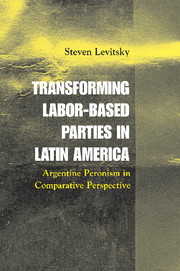Book contents
- Frontmatter
- Contents
- Figure and Tables
- Acknowledgments
- 1 Labor-Based Party Adaptation in the Neoliberal Era: Rethinking the Role of Party Organization
- 2 Origins and Evolution of a Mass Populist Party
- 3 An “Organized Disorganization”: The Peronist Party Structure in the 1990s
- 4 Populism in Crisis: Environmental Change and Party Failure, 1983–1985
- 5 From Labor Politics to Machine Politics: The Transformation of the Peronist Party–Union Linkage
- 6 Menemism and Neoliberalism: Programmatic Adaptation in the 1990s
- 7 A View from Below: Party Activists and the Transformation of Base-Level Peronism
- 8 The Paradox of Menemism: Party Adaptation and Regime Stability in the 1990s
- 9 Crisis, Party Adaptation, and Democracy: Argentina in Comparative Perspective
- References
- Index
3 - An “Organized Disorganization”: The Peronist Party Structure in the 1990s
Published online by Cambridge University Press: 22 December 2009
- Frontmatter
- Contents
- Figure and Tables
- Acknowledgments
- 1 Labor-Based Party Adaptation in the Neoliberal Era: Rethinking the Role of Party Organization
- 2 Origins and Evolution of a Mass Populist Party
- 3 An “Organized Disorganization”: The Peronist Party Structure in the 1990s
- 4 Populism in Crisis: Environmental Change and Party Failure, 1983–1985
- 5 From Labor Politics to Machine Politics: The Transformation of the Peronist Party–Union Linkage
- 6 Menemism and Neoliberalism: Programmatic Adaptation in the 1990s
- 7 A View from Below: Party Activists and the Transformation of Base-Level Peronism
- 8 The Paradox of Menemism: Party Adaptation and Regime Stability in the 1990s
- 9 Crisis, Party Adaptation, and Democracy: Argentina in Comparative Perspective
- References
- Index
Summary
The contemporary PJ retains important features from its populist and movementist past. Although it possesses a powerful mass organization with deep roots in working- and lower-class society, that organization lacks a central authority structure, an effective bureaucracy, and widely accepted and binding rules of the game. This internal fluidity has led scholars to conclude that the PJ's organizational structure is inoperative or even nonexistent, and that party leaders maintain personalistic and largely unmediated relationships with the Peronist rank and file (Novaro 1994: 76–89; Palermo and Novaro 1996: 370–6; Weyland 1999).
This chapter presents a somewhat different view. It characterizes the PJ as an informal mass party. It is a mass party in that it maintains both a large membership and activist base and an extensive base-level organization with deep roots in working- and lower-class society. Yet the PJ differs from prototypical mass working-class parties (such as European social democratic and communist parties) in that it is informally organized and weakly routinized. It is informal in that most Peronist subunits are self-organized and -operated networks – run out of unions, clubs, nongovernmental organizations, and even activists' homes – that do not appear in the party's statutes or records, and which remain unconnected to (and autonomous of) the party bureaucracy. It is weakly routinized in that its internal rules and procedures are not widely known, accepted, and complied with, but rather are fluid, contested, and widely circumvented or ignored.
- Type
- Chapter
- Information
- Transforming Labor-Based Parties in Latin AmericaArgentine Peronism in Comparative Perspective, pp. 58 - 90Publisher: Cambridge University PressPrint publication year: 2003



